There are many misconceptions about Geisha, one of the oldest and most celebrated traditions in Japan. Whilst it’s been a part of Japan’s history for thousands of years, the traditional concept made major waves across western society when the 2005 Academy-award winning film “Memoirs of a Geisha” exploded into the scene. It told the story of a young Japanese girl who made her way in life as a Geisha, and whilst there were definitely some strong and true elements reflected in the film, its reception saw many controversies and divided opinions amongst the audiences.
In particular, the majority of the Japanese audience were aghast at how the traditional role of the Geisha was portrayed – it was warped, inaccurate, and apparently highly westernised.

This film may or may not have planted the roots of the misconceptions that many foreigners have of Geisha, but it definitely played a role in the way they are often mistaken for participating in activities that their actual elite line of work does not deliberate in. It also doesn’t fully detail or do justice the amount of dedication and effort aspiring Geisha must be willing to sacrifice in order to become a full-fledged recognised Geisha.
What’s more, it is difficult these days to truly understand what makes and defines a Geisha, when the numbers have dwindled down to a tiny fraction of what they use to be. The numbers, at the peak of Geisha popularity, are relatively unknown, however during the 1920s, there was a recorded number of over 80,000 in Japan. Nowadays, almost 100 years later, there’s only a mere 270 or so Geisha and their apprentices, known as Maiko, still in practice. How times have changed!
The word Geisha itself literally translates to “artisan”, and it is in the world of traditional Japanese arts and entertainment that they truly shine. In the most generic sense, they use their talents and well-practiced techniques to provide entertainment for customers on the occasion of banquets and performances. In western Japan, including Kyoto, the term ‘Geiko’ is another, more commonly used term for Geisha, but they both mean identical things.
In this little piece of an article, we’ll attempt to dispel any common misconceptions that people have, as well as provide you with a basic but detailed understanding of how they came to be.
What Is a Geisha – History

It was in the 1700s when they were first introduced, and the 1800s when they rose to prominence. It was only during the second half of the 18th century that it was officially recognised as a profession. At first, they began as regarded as entertainers at glamourous entertainment centres around Japan.
However, as more and more entertainers became specialised in a particular type of performance, it eventually led to the emergence of Geisha. Fun fact: the first ones were actually men, who entertained the customers in waiting rooms who were visiting popular ‘oiran’ (courtesans).

Overtime, the ever-popular oiran services depleted until the profession was eradicated altogether, elevating the social status of Geisha. Up until World War II, trained and recognised Geisha throughout the country enjoyed the elite reputation they were bestowed, which saw entertainment as a positive for the population.
However, the decline in number of practicing Geisha and customers with disposable income was exacerbated by the war efforts, and around the mid-1940s, many Geisha districts unfortunately had to shut down, forcing many of them to find work elsewhere.

A year after the war, there was a resurgence in Geisha practices and activities, but by then, many original ones were comfortable in the lifestyle they’ve found and never returned. As for the Geisha who picked it back up again, some decided that it was time to incorporate Western-influences in their style of dress and way of entertainment, causing a divide.

To become a Geisha is no small feat. It takes years of dedication and practice to transform into a full-fledged Geisha, and all the hard work and effort means that it’s usually the only career path the individual forges for themselves.
To begin, one must move into a ‘okiya’ (special training houses), at the typical age of 15 (in the early ages, girls often began their training at the tender age of six years old). There, they will learn about the various forms of traditional Japanese arts and how to best perform them.
They will also learn about the strict communication standards, the various forms of hospitality that must be displayed at all times during a performance, and the multitude of situations one may find themselves in and how to deal with it.
What Is A Geisha Today?

A Geisha today holds the same morals and standards comparing to many moons ago, however, much of their circumstances have changed and whilst they have inherently held onto their roots, there are a few major changes that have assisted in assimilating them into modern society as we know it today.
One of the biggest differences that separate the Geisha in history from today is how the term ‘mizuage’ is defined. Back then, in the most generic sense, it was the ‘coming of age’ ceremony for a Maiko (apprentice Geisha) to signify that she is ready to become a Geisha. One of the long-standing supposed associations with this celebration was also the loss of one’s virginity. Whilst there have been inconsistencies with past accounts of mizuage actually pertaining to this aspect, since the post-war era in Japan, the practice has been outright legally banned.
The age that an individual has to start training to become a Geisha has also differed greatly from when it was first introduced. As mentioned before, Geisha back in the day start their training as early as six years old, whereas these days, sometimes they don’t even start until they finish high school (mid to late teens).

Today, the Geisha who exist in areas such as Kyoto, Kanazawa, and Tokyo are some of the most highly valued professional entertainers of the region. However, please note that the ones which operate in Kyoto are the most esteemed, and Kyoto is considered the most prestigious place for them. Here, the Geisha (or Geiko, in Kyoto), still live in okiyas.
Whilst in the past, the only way to experience Geisha was to know someone who knew them (connections were so important back then!). Nowadays, they have teamed up with tourism companies, ochayas (tea houses), and ryoteis (traditional Japanese restaurant) to widen the audience
However, it is still very much considered a prestigious form of entertainment, and not every establishment has the connections, nor can you just waltz in to one that does offer it and expect to experience a Geisha performance immediately. It does take time and effort to plan.

Generally speaking, ochayas are quite prestigious and are highly exclusive, and mostly allow access to regular customer who they trust. They don’t bill each event; they bill once a month for all expenses accrued.
However, since they have teamed up with tourism companies, many doors have opened up for regular tourists to book in a highly sought-after Geisha experience. Please note that they are usually quite expensive, being around the 50,000-yen mark for a full Geisha experience at dinner, not including the dinner itself.
For that amount, you can expect to be thoroughly entertained by the Geisha during dinner. They usually engage in conversation with the guests (you will most likely need to hire a translator if you don’t speak any Japanese), keep everyone’s glasses topped up, and initiate fun games which involve drinking.
The highlight of these dinners is when they actually command your full attention for their highly intricate and skilful dancing, which is accompanied by traditional music played by another Geisha on the shamisen (traditional Japanese three-stringed lute).
Difference Between a Geisha and Maiko
A Maiko is an apprentice Geisha. After a few years of thorough and intense training, a Maiko will have a mizuage ceremony to be initiated into becoming a full-fledged Geisha. There are multiple differences between the two, however we’ve listed the most important details below:
Age

Maiko usually start their training at a young age, around 15-16 in Kyoto, and 17-18 in Tokyo. Full-fledged Geisha begin at 21-23 years old.
Hairstyle
Geisha usually wear perfectly styled wigs, whereas Maiko style their hair naturally into buns. Both of these hairstyles, however, are styled by highly skilled artisans.
Hair Ornaments

Maiko, surprisingly, wear more decorated ornaments in their hair, and their designs, colours, and levels of complexity can sometimes reflect their current stage of training. Once they graduate into becoming a Geisha, they wear simple combs.
Make-Up

A Maiko will always be seen wearing a full face of white makeup. However, there will be a band of skin showing closer to the hairline. During the early stages of training, only the bottom lip will be painted red. This will advance to both lips painted in a thin red line, and then full painted lips as they become Geisha. Geisha will only have this make-up on if they are going to a special performance.
Kimono
A Maiko will wear colourful, long-sleeved kimonos (a typical Japanese garment) with a wider sash representing a bow which flows down the back. A Geisha will wear a more subtle kimono, usually one colour with shorter sleeves, a shorter sash. A Maiko will have a thicker, looser collar on their kimono, which is usually the colour red, whilst a Geisha will have a tighter white colour.
Footwear
Maiko will wear okobo (high wooden sandals), whereas Geisha will wear geta (shorter wooden sandals).
Now that you know the main differences between Geisha and Maiko, let’s do a quick test! Where is the Maiko in the picture below? Answer in the comments. 🙂

How You Can Spot A Geisha in Japan
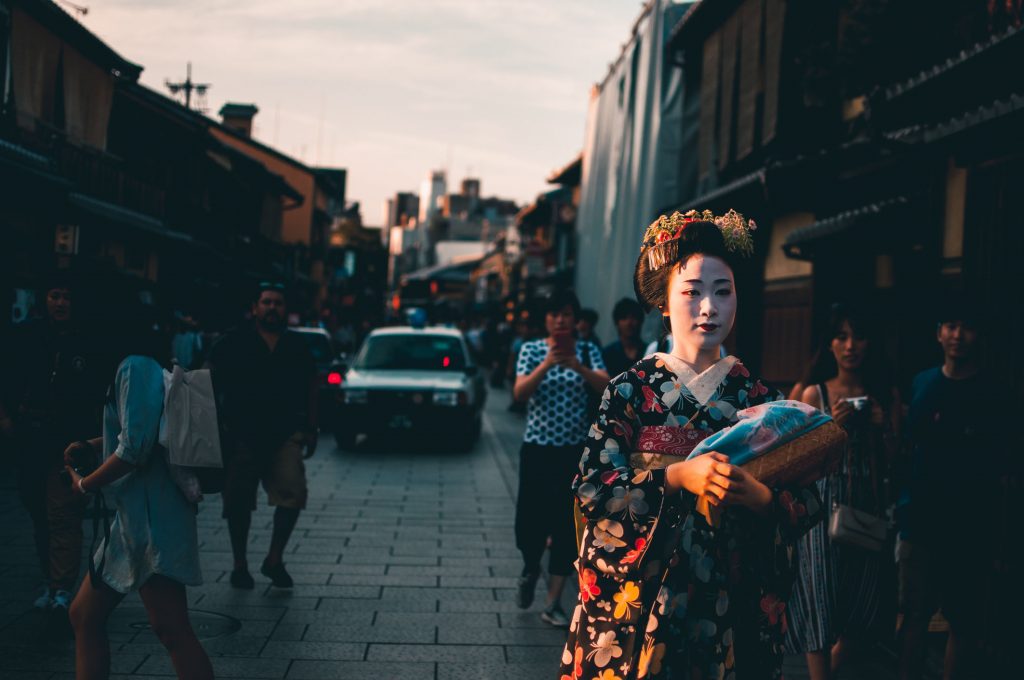
If you absolutely can’t afford to fork out for a private viewing of Geisha entertainment, there’s still hope. We have listed below some tips for you to maximise your chances of seeing them:
- After a full-on Geisha performance in Tokyo, but balk at spending a few hundred dollars on the experience? You’re in luck! The wonderful team at Voyagin are offering you the opportunity to witness the authenticity of a cultural Geisha experience, wrapped up in a succinct 90-minute activity. There will be an ochaya, traditional song and dance, Japanese games, and possibility to mingle with regulars of the ochaya involved. Interested? Find out more here!
- In Kyoto, hang around Hanami-koji-dori in Gion (towards Kennin-ji Temple), and the Shiji-dori end of Pontocho. There’s usually a bit of Geisha activity going on in these particular areas. There’s a high chance of you catching a glimpse of one heading to work usually around dusk, especially towards the end of the weekend and during the holidays. Be warned though, you will be amongst the hordes of other tourists waiting around also waiting on a chance to see a real-life Geisha. Also, be respectful, as there have been unsavoury instances where they have been mobbed by overly enthusiastic tourists.
- If you don’t want to organise your own tour of Kyoto to seek Geisha, maybe book this cool tour with Voyagin. We recommend this tour as it is a fun, relaxing and informative walking tour that takes you through the best parts of Gion where you can take in some wonderful sights. Whilst a Geisha sighting may not be guaranteed, there’s still a high chance you might spot one! To book the tour, click on this link.
- For a less traditional experience in Kyoto, you can head to the Kaburenjo Theatre, where Geisha and Maiko are known to take orders for Japanese drinks in the beer garden. It’s less pricey than booking a banquet, but the tables generally fill up quick so plan to wait a bit if you’re going during peak hours!
- For some slightly lighter entertainment, the Maiko Show in Kyoto Tower offers the audience a chance to watch afternoon performances by Maiko who are still in training. It may not be as polished as watching a group of Geisha entertain, but it’s still beautiful and unique.
- If you happen to be in Kyoto during the major festival periods, then you’re in luck. Geisha and Maiko generally get dressed up for these events, especially if they have affiliations with the associated temples and shrines. Certain festival may include:
- Yakasa Shrime Setsubun – February 2nd – 3rd
- Higashiyama Hanatoro Festival – Early – Mid-March
- Kyoto Gion Festival (this is Kyoto’s biggest festival) – July 1st – 31st
- If you are visiting the city of Kanazawa (which we highly recommend you to do), you can also enjoy a Geisha show by booking this tour.
Learning about the art of the Geisha is a wonderful thing, and we hoped we’ve enlightened you in one way or another. We understand that there are many misconceptions and whilst no one is at fault, it is an important part of Japanese history, and deserves to be known for what it truly is. The Japanese community are making solid efforts to teach the world about Geisha, and we hope from this article and associated tours that you take-away some valuable information!
And for more tips about other aspects of Japanese culture, make sure you join our Facebook Group!
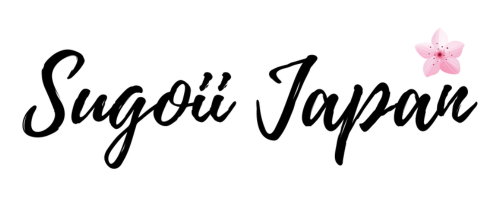





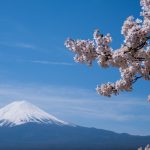

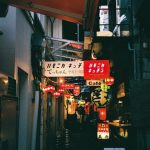
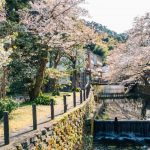
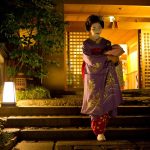
I became interested in the Geisha tradition after viewing the movie, “Sayonara.” I love the mystery of the traditions but wonder if it is appreciated in today’s society.